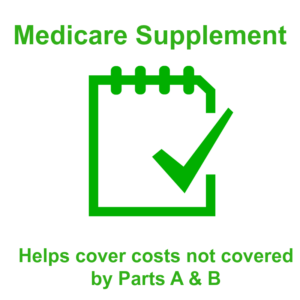If you’re on group insurance currently, how do you know if you should switch to Medicare?
It can be a tough choice to make, and if you make the wrong one, it can end up costing you a lot of money and trouble.
Having a Group Insurance Plan AND Medicare
Having two types of insurance is somewhat complicated. In these scenarios, the “coordination of benefits” rules will decide who will pay what.
Here are some guidelines provided by Medicare.gov:
- The insurance that pays first (primary payer) pays up to the limits of its coverage.
- The one that pays second (secondary payer) only pays if there are costs the primary insurer didn’t cover.
- The secondary payer (which may be Medicare) may not pay all the uncovered costs.
- If your employer insurance is the secondary payer, you may need to enroll in Medicare Part B before your insurance will pay.
What we find in these situations is that things get messy, and it’s often better to just choose one or the other.
But, how do you know if you should keep your group or make the move on over to Medicare?
Should I Keep My Group Insurance When I Turn 65?
We hate to skirt the issue here, but in all honesty, it depends on each individual situation. If we take a high-level overview of every client we’ve been able to help, it appears that switching to Medicare and adding on a Medigap plan can save most people a lot of money.
However, it completely depends on a variety of factors, such as whether your employer pays your insurance premiums and what the deductibles and copayments are.
Let’s say that your group plan costs $400 per month, your deductible is $1,500, and a regular office visit costs you $35.
On top of those costs, your coinsurance is usually around 20%.
Now, none of this really matters if your employer pays the $4000 premium, and you don’t go to the doctor much.
However, if you are paying that monthly premium, and you do go to the doctor often — or you worry that you may end up needing to — Medicare with a Medigap plan will probably save you a lot of money.
Switching to Medicare with a Medigap Plan
So, what do the costs look like when you switch from a group plan to Medicare?
Medicare Part A: $0.
Medicare Part B: $134.
Medigap Plan: Depends, but let’s say you have a Plan G which covers everything except the Part B deductible, which is $183. So, let’s say your monthly premium is $125 (which is actually high in most areas of the country).
Part D plan: Also depends on which prescriptions you have, but let’s say your premium is $40.
With your group plan, your expenses look like this:
Premium: $400 per month
Deductible: $1,500
Office copay: $35
Coinsurance: 20%
With Medicare + a Medigap plan, your expenses look like this:
Premium: $299 per month
Deductible: $183
Office copay: $0
Coinsurance: 0%
That obviously looks a lot better, doesn’t it?
Now, these numbers are just estimated figures, and they will vary wildly depending on where you live, what gender you are, your age, which carrier you choose, and so on. But this is the type of calculation that should be done when comparing these two options.
In order to figure out what your Medigap costs will be, you’ll need to get a Medigap quote. We can do that for you.
Group Insurance Plan Negatives
Group plans can be very convenient, but there are still some more factors to consider.
The first is that group plans have networks, and those networks will restrict which doctors you can go to. With Medicare, there are no networks. Medicare Advantage is another story, but Medicare with a Medigap plan will give you more freedom than a group plan.
The second is that group plans often have a really horrible deductible. Not always, but usually. We’ve even seen group insurance deductibles are high as $5,000+. With Medicare, that will never be the case. A Medigap plan will pick up that cost.
Coinsurance can be another wallet-drainer, and that’s another cost that a Medigap plan will take care of.
Finally, you have options with Medigap plans. If you get a rate increase, you can shop around and switch to a cheaper plan. Every Medigap plan is standardized by the federal government, so price shopping is really simple.
When to Make the Switch
The easy answer: talk to one of our agents and explain your individual situation.
The hard answer: it depends.
With this topic, there are so many footnotes and asterisks that it’s nearly impossible to give a straight answer.
The basic answers we can give you are that you should enroll in Medicare when you turn 65 — IF it’s looking like it’ll be cheaper than your group plan. An agent can help you make that determination.
If you’re past 65, you can switch to Medicare when you lose your group plan or when you know your group plan is going away.
How to Sign Up
Did Medicare+Medigap make the cut as the more financially prudent choice in your situation? Great!
You can apply for Medicare at your local Social Security office (Find a local SS office). To sign up for a Medigap plan, simply contact us.
_____________________
65Medicare.org is a leading, independent Medicare insurance  agency for people turning 65 and going on Medicare. We have worked with 10,000+ Medicare-eligible individuals over the last 10+ years, assisting with understanding and comparing the plans. You can get a list of Medigap quotes in your area. Or, if you have any questions about this information, you can contact us online or call us at 877.506.3378.
agency for people turning 65 and going on Medicare. We have worked with 10,000+ Medicare-eligible individuals over the last 10+ years, assisting with understanding and comparing the plans. You can get a list of Medigap quotes in your area. Or, if you have any questions about this information, you can contact us online or call us at 877.506.3378.
